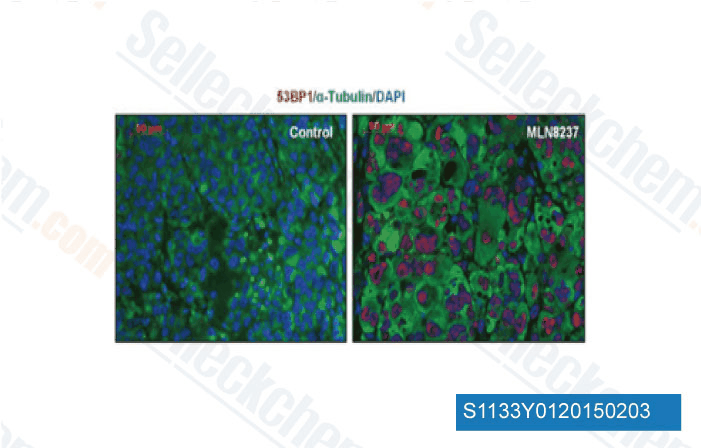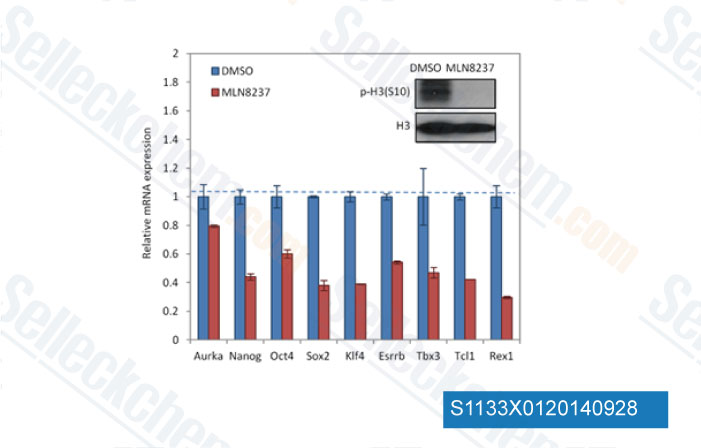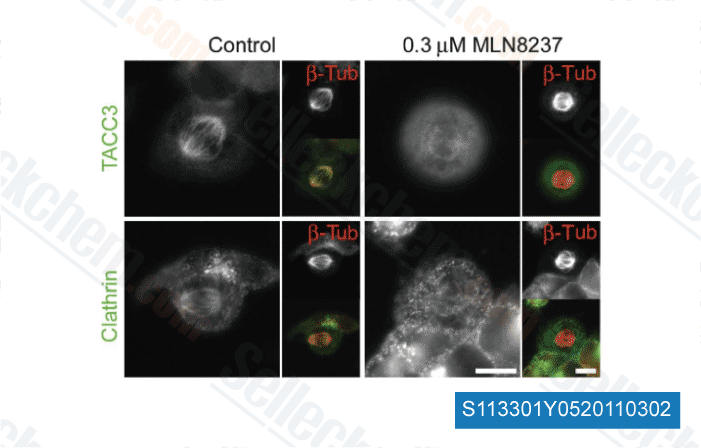|
Toll Free: (877) 796-6397 -- USA and Canada only -- |
Fax: +1-832-582-8590 Orders: +1-832-582-8158 |
Tech Support: +1-832-582-8158 Ext:3 Please provide your Order Number in the email. |
Technical Data
| Formula | C27H20ClFN4O4 |
||||||
| Molecular Weight | 518.92 | CAS No. | 1028486-01-2 | ||||
| Solubility (25°C)* | In vitro | DMSO | 100 mg/mL (192.7 mM) | ||||
| Water | Insoluble | ||||||
| Ethanol | Insoluble | ||||||
| In vivo (Add solvents to the product individually and in order) |
|
||||||
|
* <1 mg/ml means slightly soluble or insoluble. * Please note that Selleck tests the solubility of all compounds in-house, and the actual solubility may differ slightly from published values. This is normal and is due to slight batch-to-batch variations. * Room temperature shipping (Stability testing shows this product can be shipped without any cooling measures.) |
|||||||
Preparing Stock Solutions
Biological Activity
| Description | Alisertib (MLN8237) is a selective Aurora A inhibitor with IC50 of 1.2 nM in a cell-free assay. It has >200-fold higher selectivity for Aurora A than Aurora B. Alisertib induces cell cycle arrest, apoptosis and autophagy. Phase 3. | ||
|---|---|---|---|
| Targets |
|
||
| In vitro | MLN8237 shows >200-fold higher selectivity for Aurora A than the structurally related Aurora B with an IC50 of 396.5 nM, and does not have any significant activity against 205 other kinases. [1] MLN8237 (0.5 μM) treatment inhibits the phosphorylation of Aurora A in MM1.S and OPM1 cells, without affecting the Aurora B mediated histone H3 phosphorylation. MLN8237 significantly inhibits cell proliferation in multiple myeloma (MM) cell lines with IC50 values of 0.003-1.71 μM. MLN8237 displays more potent anti-proliferation activity against primary MM cells and MM cell lines in the presence of BM stroma cells, as well as IL-6 and IGF-1 than against MM cells alone. MLN8237 (0.5 μM) induces 2- to 6-fold increase in G2/M phase in primary MM cells and cell lines, as well as significant apoptosis and senescence, involving the up-regulation of p53, p21 and p27, as well as PARP, caspase 3, and caspase 9 cleavage. In addition, MLN8237 shows strong synergistic anti-MM effect with Hexadecadrol, as well as additive effect with doxorubicin and LDP-341. [2] MLN8237 (0.5 μM) treatment causes the inhibition of colony formation of FLO-1, OE19, and OE33 esophageal adenocarinoma cell lines, and induces a significant increase in the percentage of polyploid cells, and subsequently an increase in the percentage of cells in the sub-G1 phase, which can be further enhanced in combination with NSC 119875(2.5 μM), involving the higher induction of TAp73β, PUMA, NOXA, cleaved caspase-3, and cleaved PARP as compared with a single-agent treatment. [3] |
||
| In vivo | MLN8237 significantly reduces the tumor burden with tumor growth inhibition (TGI) of 42% and 80% at 15 mg/kg and 30 mg/kg, respectively, and prolongs the survival of mice compared with the control. [2] |
||
| Features | First orally available inhibitor of Aurora A. |
Protocol (from reference)
| Kinase Assay: |
|
|---|---|
| Cell Assay: |
|
| Animal Study: |
|
References
|
Customer Product Validation
-S113303W0120130926.gif)
-
Data from [Oncogene, 2014, 33, 3550-60]

-
Data from [Data independently produced by EMBO Mol Med, 2013, 5(1), 149-66]

-
Data from [Data independently produced by Cell Stem Cell, 2012, 11, 179-94]

-
Data from [EMBO J, 2012, 30, 906-19]
Selleck's Alisertib (MLN8237) has been cited by 404 publications
| Targeted inhibition of Aurora kinase A promotes immune checkpoint inhibition efficacy in human papillomavirus-driven cancers [ J Immunother Cancer, 2025, 13(1)e009316] | PubMed: 39773561 |
| An Aurora kinase A-BOD1L1-PP2A B56 axis promotes chromosome segregation fidelity [ Cell Rep, 2025, 44(2):115317] | PubMed: 39970043 |
| The AURKA inhibitor alters the immune microenvironment and enhances targeting B7-H3 immunotherapy in glioblastoma [ JCI Insight, 2025, e173700] | PubMed: 39928563 |
| Detection of senescence using machine learning algorithms based on nuclear features [ Nat Commun, 2024, 15(1):1041] | PubMed: 38310113 |
| Targeting of vulnerabilities of drug-tolerant persisters identified through functional genetics delays tumor relapse [ Cell Rep Med, 2024, 5(3):101471] | PubMed: 38508142 |
| The Eμ-Ret mouse is a novel model of hyperdiploid B-cell acute lymphoblastic leukemia [ Leukemia, 2024, 38(5):969-980] | PubMed: 38519798 |
| Meningioma achieves malignancy and erastin-induced ferroptosis resistance through FOXM1-AURKA-NRF2 axis [ Redox Biol, 2024, 72:103137] | PubMed: 38642502 |
| A novel role of AURKA kinase in erythroblast enucleation [ Haematologica, 2024, 109(11):3721-3734] | PubMed: 38961734 |
| WEE1 confers resistance to KRASG12C inhibitors in non-small cell lung cancer [ Cancer Lett, 2024, 611:217414] | PubMed: 39725152 |
| NINJ1 regulates ferroptosis via xCT antiporter interaction and CoA modulation [ Cell Death Dis, 2024, 15(10):755] | PubMed: 39424803 |
RETURN POLICY
Selleck Chemical’s Unconditional Return Policy ensures a smooth online shopping experience for our customers. If you are in any way unsatisfied with your purchase, you may return any item(s) within 7 days of receiving it. In the event of product quality issues, either protocol related or product related problems, you may return any item(s) within 365 days from the original purchase date. Please follow the instructions below when returning products.
SHIPPING AND STORAGE
Selleck products are transported at room temperature. If you receive the product at room temperature, please rest assured, the Selleck Quality Inspection Department has conducted experiments to verify that the normal temperature placement of one month will not affect the biological activity of powder products. After collecting, please store the product according to the requirements described in the datasheet. Most Selleck products are stable under the recommended conditions.
NOT FOR HUMAN, VETERINARY DIAGNOSTIC OR THERAPEUTIC USE.
